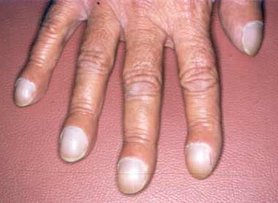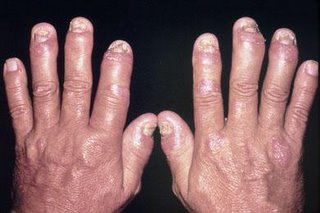Unlike tuberculous osteomyelitis, which typically involved the thoracic and lumbar spine (50 percent of cases), tuberculous arthritis primarily involves the large weight-bearing joints, in particular the hips, knees, and ankles, and only occasionally involves smaller non weight bearing joints.
Progressive monarticular swelling and pain and develop over months to years, and systemic symptoms are seen in only half of all cases. Coexistent active pulmonary tuberculosis is unusual.
Aspiration of involved joint yields fluid with an average cell count of 20,000/µL, with approximately 50 percent neutrophils. Acid fast staining of the fluid yields positive results in fewer than one-third of cases, and cultures are positive in 80 percent.




 RA hands: symmetrical deforming arthropathy with synovial thickening.
RA hands: symmetrical deforming arthropathy with synovial thickening. Psoriatic arthropathy: asymmetrical arthropathy involving terminal IPJ with nail changes.
Psoriatic arthropathy: asymmetrical arthropathy involving terminal IPJ with nail changes. Chronic tophaceous gout: asymmetrical deforming arthropathy with tophi formation.
Chronic tophaceous gout: asymmetrical deforming arthropathy with tophi formation.



